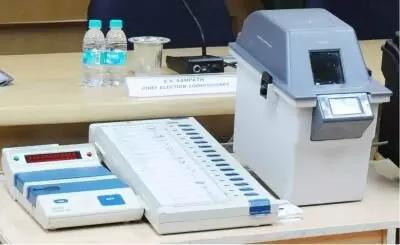Timely resolution

Coinciding with the second phase of polling, the Supreme Court’s verdict dismissing petitions calling for 100 per cent verification of votes cast on electronic voting machines (EVMs) with slips printed by the Voter Verifiable Paper Audit Trail (VVPAT) machines appears to be a well-balanced, timely decision. The answers to certain questions surrounding transparency of India’s contemporary electoral exercise were long overdue.
The court referred to “the protocol in place, technical aspects and data which is on record” to arrive at its dictum. In doing so, it has aptly rejected the idea of returning to the ballot box voting. Irrespective of the allegations of irregularities in EVM voting, the court’s decision seems to have chosen progression over regression. One may quite easily recall that voting through ballot boxes was not free of ills. Rather than sliding backwards, the court has acknowledged the need to weed out the shortcomings of EVM voting—an acknowledgement that equally tries to address the apprehensions of petitioners and opposition parties, but through a more pragmatic method.
Pointing out that “blindly distrusting any aspect of the system can breed unwarranted scepticism and impede progress”, the apex court emphasised on the need for a “critical yet constructive approach guided by evidence and reason… to make room for meaningful improvements and to ensure the system’s credibility and effectiveness.”
To facilitate the improvements desired by the petitioners, the court gave several directions. By mandating the sealing and storage of Symbol Loading Units (SLUs) for 45 days after election, the court has ensured the preservation of critical components for potential verification.
Furthermore, the court directed that a team of engineers from EVM manufacturers will check and verify the burnt memory semi-controller in 5% of EVMs (Control Unit, Ballot Unit, and VVPAT) per assembly or parliamentary constituency segment after results announcement, upon request by candidates ranked 2nd or 3rd, for tampering or modifications. This can serve as a safeguard against tampering while facilitating candidates' participation in the verification process.
The court's suggestion for the Election Commission of India (ECI) to explore the feasibility of electronic machines for counting VVPAT paper slips, coupled with the inclusion of barcodes for party identification, is yet another pragmatic approach to streamline the verification process. Such technological innovations, if implemented judiciously, could prove to be a gamechanger in ensuring the reliability of the electoral machinery, without causing considerable disruptions. This simple yet effective suggestion has the potential to allay the concerns of petitioners.
VVPATs serve as a vital tool for securing public trust in the integrity of elections. However, the debate over the extent of VVPAT verification had to be balanced in a manner that would ensure electoral integrity and avoid undue delays in result declaration. The Supreme Court verdict has done exactly the same. It was never a question of “delay” vs “integrity”, but of integrity and timeliness. It may be pertinent to note here that the five per cent VVPAT verification sample size, recommended by the Indian Statistical Institute (ISI), is claimed to be “mathematically sound, statistically robust and practically cogent”.
To sum up, the calls for expanded VVPAT verification reflect a legitimate desire to uphold the sanctity of elections and safeguard democratic principles. While these demands for heightened scrutiny merit consideration, it is essential to weigh them against practical constraints, including logistical challenges and potential delays in result declaration. There is a need for pragmatic solutions that reconcile competing interests while upholding the integrity of the electoral process.



